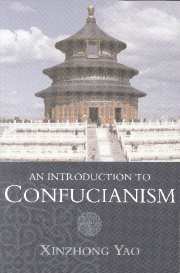Book contents
- Frontmatter
- Contents
- List of illustrations
- Preface
- Confucianism in history: chronological table
- Introduction: Confucian studies East and West
- 1 Confucianism, Confucius and Confucian classics
- 2 Evolution and transformation – a historical perspective
- 3 The Way of Confucianism
- 4 Ritual and religious practice
- 5 Confucianism and its modern relevance
- Select bibliography
- Transliteration table
- Index
- Plate section
Introduction: Confucian studies East and West
Published online by Cambridge University Press: 05 June 2012
- Frontmatter
- Contents
- List of illustrations
- Preface
- Confucianism in history: chronological table
- Introduction: Confucian studies East and West
- 1 Confucianism, Confucius and Confucian classics
- 2 Evolution and transformation – a historical perspective
- 3 The Way of Confucianism
- 4 Ritual and religious practice
- 5 Confucianism and its modern relevance
- Select bibliography
- Transliteration table
- Index
- Plate section
Summary
If we were to characterize in one word the Chinese way of life for the last two thousand years, the word could be ‘Confucian’. No other individual in Chinese history has so deeply influenced the life and thought of his people, as a transmitter, teacher and creative interpreter of the ancient culture and literature and as a moulder of the Chinese mind and character.
(de Bary, et al., 1960, vol. I: 15)At the end of the sixteenth century, an Italian Jesuit Matteo Ricci (1552–1610) arrived in China. Ricci soon realised that the first task for him should not be to win over a great number of people to conversion and baptism, but instead to try to secure a stable and respectable position for himself within Chinese society. So Ricci and his fellow missionaries strenuously attempted to integrate themselves into the community. The Jesuits saw a similarity between Christianity and Buddhism – both were religions from the West – and therefore they presented themselves as ‘Monks from the West’, shaving their heads and changing their clothes to Buddhist robes in order to win the support from the Chinese, just as they thought the Buddhists had done a thousand years before. However, it was not too long before the missionaries realised that the Buddhists were not so highly regarded as they had at first imagined. They discovered that in fact it was Confucian scholars who were the true social elite of Chinese society.
Information
- Type
- Chapter
- Information
- An Introduction to Confucianism , pp. 1 - 15Publisher: Cambridge University PressPrint publication year: 2000
